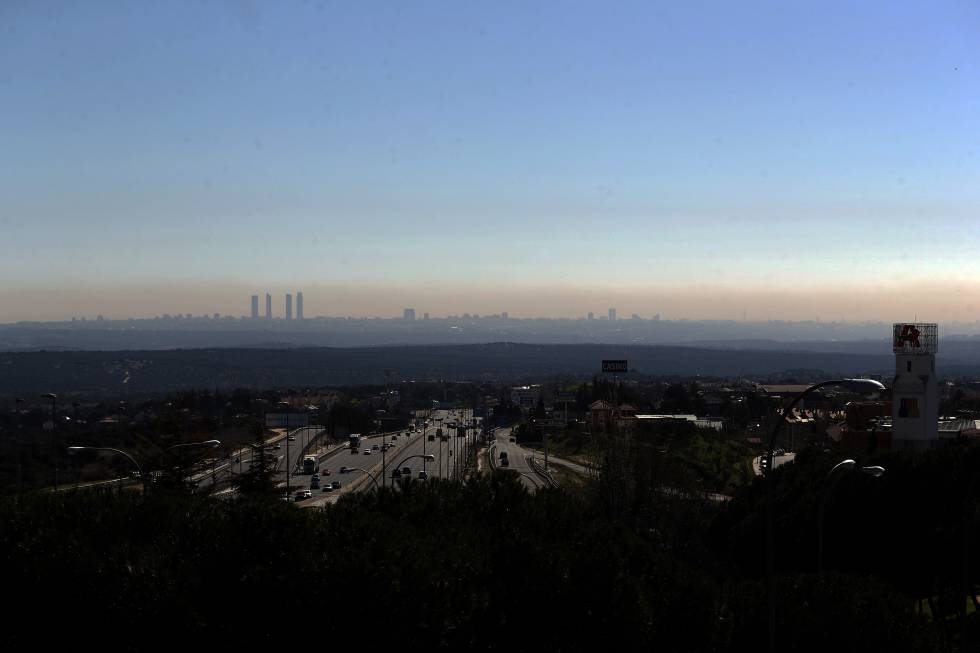CLIMATE CHANGE
Spain’s major cities still failing in fight against pollution
Madrid and Barcelona once again exceeded European limits for nitrogen dioxide in 2016
Madrid
Spain has systematically failed to comply with European regulations aimed at limiting pollution in cities since the regulations were created in 2010. The country’s largest urban centers have failed to meet these limits and experts conclude that stronger pollution-prevention plans are needed, in addition to restrictions that are only applied when pollution is at its highest.

Smog over Madrid in March 2017. ULY MARTÍN
Madrid’s City Council has just announced that in 2018 the Spanish capital will implement permanent traffic restrictions to try and comply with Brussels, which has two case files open on Spain for this reason. Traffic is the main cause of the low air quality in and around Spanish cities.
The Ministry of Agriculture and Fisheries, Food and Environment published a report evaluating air quality in Spain in 2016, which will be sent to the European Commission. Although the ministry indicates that air quality has “slightly improved” since 2015, the department’s analysis continues to detect violations of the European standard, which sets limits for major pollutants.
Traffic is the main reason for the low air quality in Spanish cities
Nitrogen dioxide (NO2) – the most problematic pollutant, which causes respiratory problems and is emitted from exhaust pipes – is found in excess levels in seven urban areas of Spain. According to the report, those metropolitan areas are Barcelona and Vallès-Baix Llobregat in the northeast region of Catalonia; Madrid and Henares in the center of the country; Valencia on the Mediterranean coast; Granada in the south; and San Sebastián de la Gomera in the Canary Islands. In all cases, except in the case of the Canary Islands, the violations are “mainly due to traffic.”
The northern Spanish city of Bilbao was left off this list, despite its previous inclusion, but the Basque government’s own reports claim that the northern region also exceeded the annual limits.
“Chronic non-compliance”
Miguel Ángel Ceballos, of Ecologists in Action – an organization that also monitors this problem annually – says Madrid and Barcelona have settled into “chronic non-compliance.”
“They have failed to comply year after year with regulations since enforcement began in 2010,” he says. Ceballos applauds Madrid’s new plan since “it adopts measures for permanent reductions” of contamination. “Barcelona does not have those ambitious goals,” he says.
Last February, the European Commission sent a “final warning” to Spain for the “constant non-compliance with the limits of atmospheric pollution of nitrogen dioxide” – which, Brussels stated, “poses a serious health risk” – in Madrid and Barcelona.
Spain has failed to comply year after year with regulations since enforcement began in 2010MIGUEL ÁNGEL CEBALLOS, ENVIRONMENTAL ACTIVIST
Spain has also failed to limit PM10particulate matter, which also comes from traffic and industry. But the environment ministry stresses that only one area exceeded the annual limit for PM10 in 2016: central Asturias, in Spain’s northwest. Spain also needs to monitor tropospheric ozone, which is more difficult to fight against as solar radiation plays a role along with traffic and industry. The ministry said in its report that in 2016, the situation was “similar to that of previous years, although there is a small decline in the number of areas that exceed the target values.”
“We have slightly improved the quality of our air compared to 2015,” says the ministry in conclusion. The problem, according to Ceballos, is that the situation “can be reversed in the future for meteorological reasons.” This means all the good work could be undone if there is a bad year with many thermal inversions in winter and high temperatures in the spring. That is why he is calling for structural measures to be put in place.
English version by Debora Almeida.



Southern Spain facing desertification if CO2 emissions not brought down







































No hay comentarios:
Publicar un comentario